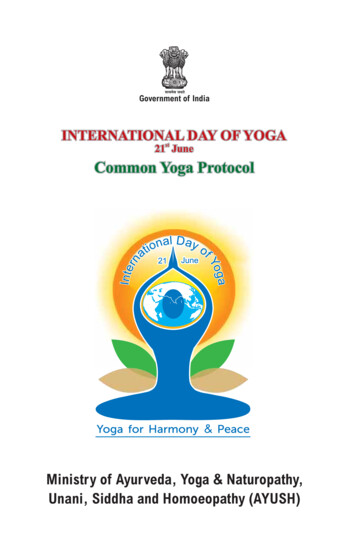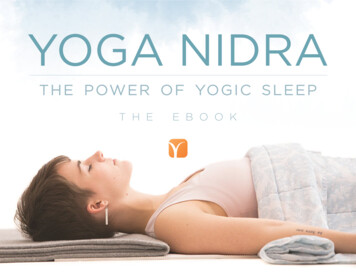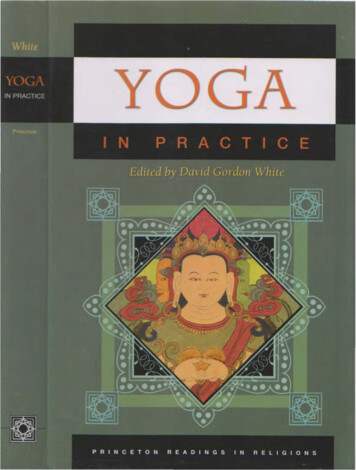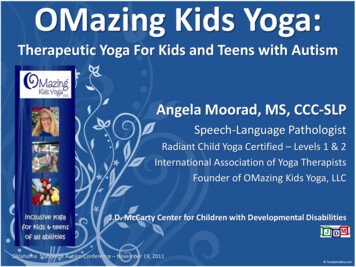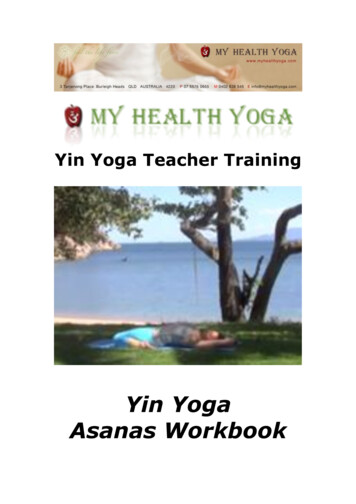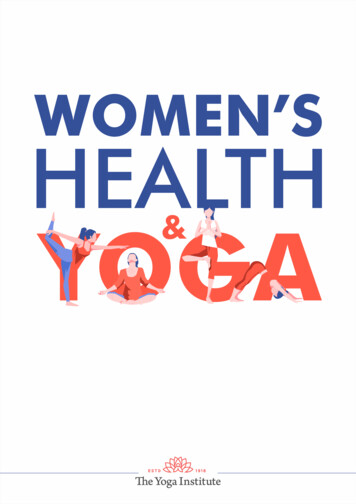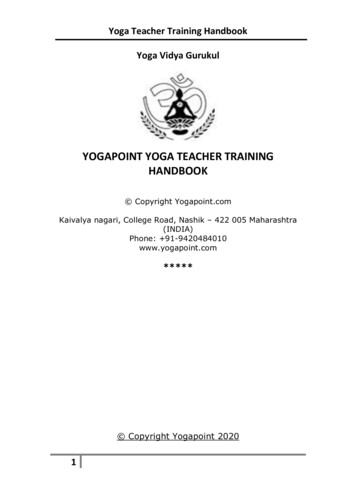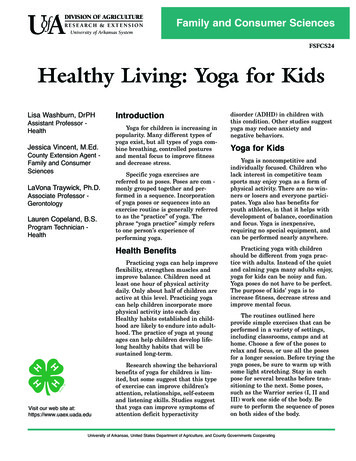
Transcription
DIVISION OF AGRICULTURERESEARCH & EXTENSIONUniversity of Arkansas SystemFamily and Consumer SciencesFSFCS24Healthy Living: Yoga for KidsLisa Washburn, DrPHAssistant Professor HealthJessica Vincent, M.Ed.County Extension Agent Family and ConsumerSciencesLaVona Traywick, Ph.D.Associate Professor GerontologyLauren Copeland, B.S.Program Technician HealthIntroductionYoga for children is increasing inpopularity. Many different types ofyoga exist, but all types of yoga com bine breathing, controlled posturesand mental focus to improve fitnessand decrease stress.Specific yoga exercises arereferred to as poses. Poses are com monly grouped together and per formed in a sequence. Incorporationof yoga poses or sequences into anexercise routine is generally referredto as the “practice” of yoga. Thephrase “yoga practice” simply refersto one person’s experience ofperforming yoga.Health BenefitsPracticing yoga can help improveflexibility, strengthen muscles andimprove balance. Children need atleast one hour of physical activitydaily. Only about half of children areactive at this level. Practicing yogacan help children incorporate morephysical activity into each day.Healthy habits established in child hood are likely to endure into adult hood. The practice of yoga at youngages can help children develop life long healthy habits that will besustained long term.Visit our web site at:https://www.uaex.uada.eduResearch showing the behavioralbenefits of yoga for children is lim ited, but some suggest that this typeof exercise can improve children’sattention, relationships, self esteemand listening skills. Studies suggestthat yoga can improve symptoms ofattention deficit hyperactivitydisorder (ADHD) in children withthis condition. Other studies suggestyoga may reduce anxiety andnegative behaviors.Xoga for KidsYoga is noncompetitive andindividually focused. Children wholack interest in competitive teamsports may enjoy yoga as a form ofphysical activity. There are no win ners or losers and everyone partici pates. Yoga also has benefits foryouth athletes, in that it helps withdevelopment of balance, coordinationand focus. Yoga is inexpensive,requiring no special equipment, andcan be performed nearly anywhere.Practicing yoga with childrenshould be different from yoga prac tice with adults. Instead of the quietand calming yoga many adults enjoy,yoga for kids can be noisy and fun.Yoga poses do not have to be perfect.The purpose of kids’ yoga is toincrease fitness, decrease stress andimprove mental focus.The routines outlined hereprovide simple exercises that can beperformed in a variety of settings,including classrooms, camps and athome. Choose a few of the poses torelax and focus, or use all the posesfor a longer session. Before trying theyoga poses, be sure to warm up withsome light stretching. Stay in eachpose for several breaths before tran sitioning to the next. Some poses,such as the Warrior series (I, II andIII) work one side of the body. Besure to perform the sequence of poseson both sides of the body.University of Arkansas, United States Department of Agriculture, and County Governments Cooperating
Sample Standing Pose RoutineThe following ten standing yoga poses do not require sitting or lying on the floor. No yoga mat is needed!Mountain Pose1. Stand tall, feet hip width apart, shoulders relaxed, chest lifted.2. Flex your toes up to engage your legs.3. You can either let your arms hang down at your sides or pressyour palms together at the chest.Tree Pose1. Stand in Mountain Pose.2. With palms together at the chest, tuck one foot inside theopposite leg. Place your foot above or below, but not directlyon, your knee.3. Stretch your arms out like branches.4. Bring your hands together above your head.5. Repeat on the other side.Warrior I1. From Mountain Pose, take a big step forward with one foot into a high lungeposition.2. Press the heel of your back foot down into the floor.3. Bring your hands to your thighs.4. If your strength allows, sink into a Deep Lunge, making sure that the knee doesnot bend past the ankle as you reach both arms up to the sky.5. Repeat on the other side.Warrior II1. From Mountain Pose, take a large step back with your left foot (or move fromWarrior I into Warrior II by lowering arms).2. Turn your left leg/foot out and the heel in. Keep your right leg and footforward. Position the left leg and foot so that the arch of the left footlines up with the heel of the right foot.3. Raise your arms so your right arm is pointing in front of you and yourleft arm is pointing behind you, holding them parallel to the floor.4. Turn your head to the right and bend your right knee. Try to bendyour knee into a right angle so your thigh is almost parallel to thefloor. Do not move the right knee forward past the ankle. If the kneemoves past the ankle, walk the foot forward until the knee is directlyover the ankle.5. Repeat on the other side.
Warrior III1. From Mountain Pose, take a step back with one foot so that yourtoes are resting lightly on the floor.2. Hinge forward at the waist and raise your back leg off the floor.Try to make your torso and raised leg parallel to the floor.3. Keep both legs as straight as possible.4. Stretch your arms forward. To make the pose less challenging,stretch your arms out to the side like a “T”, or bring the armsback and close to the body, with the hands at hip level.5. Repeat on the other side.Rag Doll1. From Mountain Pose, bend forward from the hips; be sure not to lock your knees.2. Loosen your neck and let your neck, head and arms hang down.3. Slowly straighten back up to standing.Triangle Pose1. From Mountain Pose, take a big step back with your left footinto Warrior II.2. Bend sideways at the waist, reaching your right handtoward your right ankle.3. Raise your left hand toward the ceiling so that your armsform a straight line. Both palms should be facing forward.4. Repeat on the other side.Half Moon Pose1. From Mountain Pose, shift your weight to your right leg.2. Bend sideways at the waist and place your right hand on the floor nextto your right foot.3. Raise your left leg so that it is parallel to the floor and raise your leftarm straight up so that your arms form a straight line.4. Repeat on the other side.Dancer Pose1. Stand tall in Mountain Pose.2. Reach behind you with your right hand and hold the top of your right foot.3. Bend forward as you press your leg up and back. Try to get the upper partof your right leg parallel to the floor.4. Arch your back as you lift and extend your arms and leg.5. Repeat on the other side.
Frog Pose1. Stand with your feet hip width apart.2. Balancing on your feet, squat to the ground. Place your palms on the floorbetween your feet.3. You can press your knees out to the sides with your elbows to increase thestretch in your hips. Hold briefly.4. Leap as high in the air as you can, like a frog. Repeat the position severaltimes, seeing how high you can jump.Sample Floor Pose RoutineThis series of nine exercises requires getting on the floor. Use a mat or towel for cushion when performingthese poses.Tabletop1. Come onto the floor on your hands and knees.2. Make sure your hands are directly below yourshoulders, your knees are directly below yourhips and hip width apart, and your back is flat.Plank1. Come onto the floor and get into Tabletop.2. Walk both feet backwards until your body isparallel to the floor. Be sure to keep your hipsdown.3. Your arms should be straight, with your handsdirectly below your shoulders.4. Tighten your abdominal muscles to help keepyour back from swaying.Cobra!1. Lay down on your stomach, face down with your hands placedunder your shoulders.2. Gently press your shoulders up and off the floor by lightly pushingyour hands into the floor.3. Bend your elbows and lower back to the starting position.*For a more challenging pose, try Up Dog. From Cobra Pose, engageyour core muscles, and push through the hands and tops of the feet toslightly lift the knees from the floor. Your legs should be parallel to thefloor, raised just an inch or two.
Down Dog1. Come onto the floor into Tabletop.2. Spread your palms and turn your toes under. Press yourhips up into the air and back, and lift your knees away fromthe floor.3. At first, keep your knees slightly bent and your heels liftedaway from the floor.4. Then stretch your legs straight and push your heels downtoward the floor. Keep your arms strong. Straighten knees,but be sure not to lock them.5. Keep your head between your upper arms; don’t let it hang.6. Jump or walk your feet toward your hands and roll up tostanding position OR lower your body into Cobra Pose.Hero Pose1. Come onto the floor and stand on your knees.2. Sit back on your heels and place your hands on yourthighs.Extended Child's Pose1. Sit on the floor in Hero.2. Bend forward at the hips and fold forward, extendingyour arms in front of you with palms facing down.Camel Pose1. Stand on your knees with your legs andknees hip width apart.2. Press the tops of your feet into the floor,push your thighs forward, bring yourhands to your lower back and lift yourchest.3. Keep lifting your chest and bring yourhands to your heels.4. Let your head drop back into a comfortableposition.
Side Plank1. Stand on your knees.2. Extend your left leg straight out to the left.Place your right hand under the rightshoulder and stretch your left arm up towardthe ceiling.3. Press down into your hand and foot. Slide theright foot under the left.4. Repeat on the other side.Bridge1. Start by lying on your back with your knees bent.2. Place feet hip width apart and press them into the floor.3. Bring your elbows close to your sides and place the palms of yourhands on the floor.4. Raise your hips until your body is in a straight line from yourknees to your shoulders, pressing down into your arms.5. To lower, move your hands to your sides and slowly lower yourback, starting from your chest and rolling down.ReferencesGalantino, M., R. Galbavy and L. Quinn (2008). Therapeuticeffects of yoga for children: a systematic review of theliterature. Pediatric Physical Therapy 20(1):66 80.Kaley Isley, L., J. Peterson, C. Fischer and E. Peterson (2010).Yoga as a complementary therapy for children andadolescents: a guide for clinicians. Psychiatry, 7(8):20 32.Harrison, L., R. Manocha and K. Rubia (2004). Sahaja yogameditation as a family treatment programme for childrenwith attention deficit hyperactivity disorder. Clinical ChildPsychology and Psychiatry, 9(4):479 497.Printed by University of Arkansas Cooperative Extension Service Printing Services.DR. LISA WASHBURN is assistant professor health, JESSICA VINCENTis county Extension agent family and consumer sciences, DR. LaVONATRAYWICK is associate professor gerontology, and LAUREN COPELANDis program technician health with the University of Arkansas Division ofAgriculture. Washburn, Traywick and Copeland are located in Little Rock,and Vincent is located in Hot Springs.FSFCS24 PD 3 2014RVIssued in furtherance of Cooperative Extension work, Acts of May 8 andJune 30, 1914, in cooperation with the U.S. Department of Agriculture,Director, Cooperative Extension Service, University of Arkansas. TheArkansas Cooperative Extension Service offers its programs to all eligiblepersons regardless of race, color, national origin, religion, gender, age, dis ability, marital or veteran status, or any other legally protected status, andis an Affirmative Action/Equal Opportunity Employer.
Healthy Living: Yoga for Kids. Lisa Washburn, DrPH. Assistant Professor . From Mountain Pose,take a large step back with your left foot (or move from Warrior I into Warrior II by lowering arms). 2. Turn your left leg/foot out and the heel in.Keep your right leg and foot forward.Position the left leg and foot so that the arch of the left .
